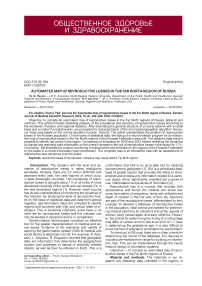Automated map of reproductive losses in the far north region of Russia
Автор: Pavlov Ya.N., Savvina N.V.
Журнал: Саратовский научно-медицинский журнал @ssmj
Рубрика: Общественное здоровье и здравоохранение
Статья в выпуске: 3 т.18, 2022 года.
Бесплатный доступ
Objective: to compile an automated map of reproductive losses in the Far North regions of Russia. Material and methods: This article includes statistical analysis of the prevalence and structure of reproductive losses according to the worldwide, Russian, and regional statistics. After describing the general structure of a neural network with a radial basis and a model of a radial neuron, we proceeded to characterization of the error backpropagation algorithm. Hence, our study was based on the normal deviation function. Results. The article substantiates the problem of reproductive losses of the Russian population. On the basis of statistical data, the listing of a neural network program for an interactive map of reproductive losses in the Far North regions of the Russian Federation was built. The obtained data made it possible to identify risk zones in the region. Comparison of indicators for 2000 and 2022 helped revealing the dynamics of change and reporting valid information on the overall increase in the risk of reproductive losses in the region by 17%. Conclusion. We proposed to conduct monitoring of reproductive loss indicators in the regions of the Russian Federation on the basis of a neural information map construction. The compiled map is an interactive map with an assessment of reproductive loss dynamics over the years.
Far north regions, interactive map, neural network, reproductive losses of the population
Короткий адрес: https://sciup.org/149141565
IDR: 149141565
Список литературы Automated map of reproductive losses in the far north region of Russia
- Bryukhanova EA, Krupochkin YP, Rygalova MV. Geoinformation technologies in the reconstruction of the social space of Siberian cities at the turn of the 19-20th centuries (Case study of the city of Tobolsk). Journal of Siberian Federal University. Humanities & Social Sciences 2018; 8 (11): 1229-42.
- Ablyazov K, Ablyazov L, Singatulin R. Geoinformation interactive mobile medical system. InterCarto. InterGIS 2016; (2): 44-51.
- Kazarin SV, Svechnikova NY, Pogorelova EV. Digital healthcare in the Russian Federation: systems and technologies. In: SI Ashmarina, VV Mantulenko (eds). Global challenges and prospects of the modern economic development 2020; (79): 1445-9.
- Lebedev G, Polikarpov A, Golubev N, et al. The geographic information system of the Russian Federation Ministry of Healthcare. KES-IDT2020; (12): 74-9.
- Mapping Edinburgh's social history: A capital digital resource. 2017. URL: http://gtr.rcuk.ac.uk/project/8A5E20E4-ACD2-4248-97A0-5D6F10AA74FC (15 Feb 2022).
- Stupen N, Ryzhok Z, Stupen M, et al. Analysis of the Interrelations Between Elements of Geoinformation System Structure. 2020 IEEE 15th International Conference on Computer Sciences and Information Technologies (CSIT) 2020; (1): 88-91.
- Yamashkin SA, Yamashkin AA, Zarubin O, et al. Geoinformation methods and technologies in the study of natural and social production systems. Other Topics: Engineering Research eJournal.2019; (7): 11-9.


